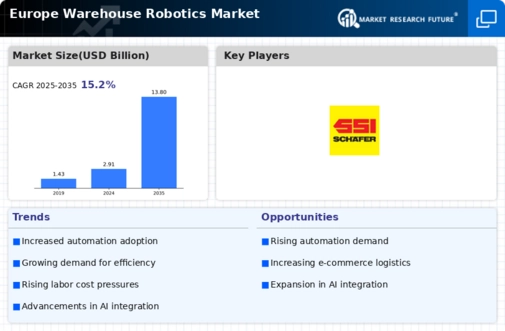Market Trends
Key Emerging Trends in the Europe Warehouse Robotics Market
The Europe warehouse robotics market is experiencing a range of trends that are shaping the industry's trajectory. One prominent trend is the rising adoption of collaborative robots, or cobots, in warehouse operations. These robots work alongside human workers, enhancing efficiency and productivity. Cobots are designed to perform tasks that require precision and repetition, allowing human workers to focus on more complex and strategic aspects of warehouse management. This collaborative approach to automation reflects a shift towards human-robot collaboration, creating a more flexible and adaptive working environment.
Another notable trend in the Europe warehouse robotics market is the integration of artificial intelligence (AI) and machine learning (ML) technologies. Advanced algorithms enable warehouse robots to learn from experience, adapt to changing environments, and optimize their performance over time. AI-powered robotics systems can analyze data in real-time, improving decision-making processes and enhancing the overall efficiency of warehouse operations. The integration of AI and ML is fostering a new era of smart and autonomous warehouse robotics.
The increasing demand for robotic solutions with modular and scalable designs is also a key trend in the market. Warehouse operators seek flexible robotics systems that can easily adapt to changing workloads and operational requirements. Modular designs allow for easy customization and expansion, enabling businesses to scale their robotic fleet based on evolving needs. This trend reflects the industry's response to the dynamic nature of logistics and supply chain operations, where adaptability is a critical factor for success.
Furthermore, there is a growing trend towards the deployment of mobile robots and autonomous guided vehicles (AGVs) in warehouse settings. These robots are designed to navigate warehouse environments autonomously, optimizing the movement of goods and reducing the need for fixed infrastructure such as conveyor systems. Mobile robots offer increased flexibility in warehouse layouts, allowing for efficient space utilization and quick reconfiguration to accommodate changing demands. This trend aligns with the push for agile and responsive warehouse solutions.
The focus on sustainability is influencing market trends in the Europe warehouse robotics sector. As businesses increasingly prioritize environmentally friendly practices, there is a growing demand for robotic solutions that align with sustainable principles. Energy-efficient robots, designed to minimize resource consumption and waste, are gaining traction. This trend reflects the industry's commitment to reducing its environmental footprint and contributing to eco-friendly warehouse operations.
E-commerce growth is a significant driver of market trends in the Europe warehouse robotics sector. The surge in online shopping has led to an increased demand for fast and accurate order fulfillment. Warehouses are adapting to this trend by deploying robotics systems that can handle high-throughput requirements and support efficient e-commerce logistics. The integration of robotics is seen as a crucial enabler for meeting the challenges posed by the rapid expansion of the e-commerce market.
Moreover, the trend towards robot-as-a-service (RaaS) models is gaining momentum in the Europe warehouse robotics market. Instead of traditional ownership models, businesses are exploring the option of leasing robotic solutions on a subscription basis. RaaS models offer financial flexibility, allowing companies to access the latest robotics technology without a significant upfront investment. This trend reflects a shift towards more cost-effective and scalable approaches to adopting warehouse robotics.
The COVID-19 pandemic has accelerated certain market trends, such as the emphasis on contactless and touchless solutions in warehouse robotics. The need for social distancing and reduced human contact in the workplace has led to increased interest in touch-free robotic systems that can operate autonomously. This trend underscores the role of robotics in ensuring business continuity and operational resilience in the face of unforeseen challenges.



Leave a Comment